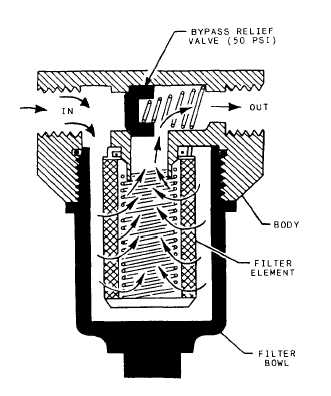construction to the sintered bronze element described previously. The design is usually a corrugated, sintered, stainless steel mesh, such as the magnified cross section shown in view (D) of figure 10-29. One manufacturer calls the design a "Dutch Twill" pattern. The curved passages of the filter element (through which the fluid passes) limit the length of the particles that pass through the element. Most filters that use the stainless steel are equipped with a contamination indicator, described later in this chapter.
Filter Classifications
The hydraulic systems of CESE use several different types of filters. There are a number of factors to be considered in determining the full classification of a particular type of filter. When hydraulic filters are being classified, the following factors are considered:
1. Flow characteristics
2. Filtering medium
3. Bypass characteristics
4. Contamination indicators
FLOW CHARACTERISTICS. - In the full - flow filter, all the fluid that enters the unit passes through the filter element, while in a proportional flow, only a portion of the fluid passes through the element. Practically all filters used in the hydraulic systems of CESE are full flow.
FILTERING MEDIUM. - The different filter elements - wire mesh, micronic, and porous - were discussed earlier. Normally, only one element is used in each filter; however, some equipment uses two or more elements in order to obtain the desired degree of filtration.
A full-flow, micronic, bypass filter is shown in figure 10-30. This filter provides a positive filtering action; however, it offers resistance to flow, particularly when the element becomes dirty. For this reason, a full-flow filter usually contains a bypass valve; the valve automatically opens to allow the fluid to bypass the element when the flow of fluid is restricted because of contamination buildup on the element.
Hydraulic fluid enters the filter assembly through the inlet port in the body and flows around the filter element inside the filter bowl. Filtering takes place as the fluid passes through the filter element and into the hollow core, leaving dirt and impurities deposited on the outside of the filter medium. The filtered fluid then flows from the hollow core, through the outlet port, and continues on through the system.
BYPASS CHARACTERISTICS. - TMS bypass relief valve in the body allows the fluid to bypass the filter element and pass directly into the outlet port if the filter element becomes clogged. In many micronic filters, the relief valve is set to open when the differential in pressure exceeds 50 psi; for example, if the pressure at the filter inlet port is 90 psi and the pressure at the outlet drops below 40 psi, the bypass valve opens and allows the liquid to bypass the element.
ATTENTION: Oil that bypasses the hydraulic oil filter is unfiltered oil. his is a clear indication of a hydraulic system in need of serious maintenance, repair or both.
CONTAMINATION INDICATORS. - Contamination indicators are often used on bypass filters. The full-flow, porous metal, bypass electrical-indicating

Figure 10-30.-Full-flow, bypass type of hydraulic filter.
Continue Reading